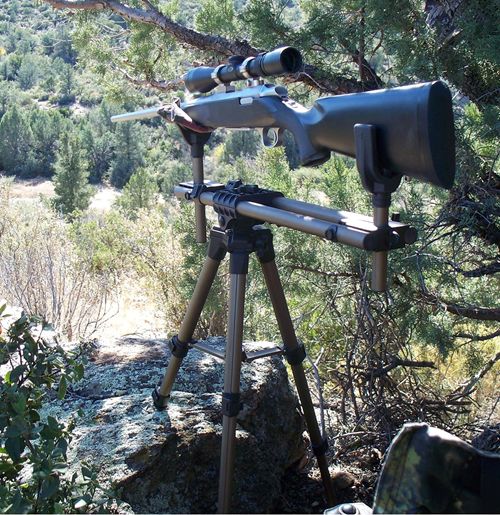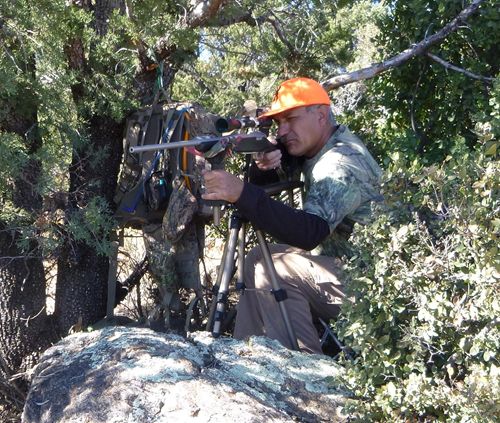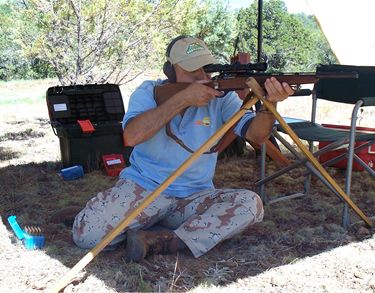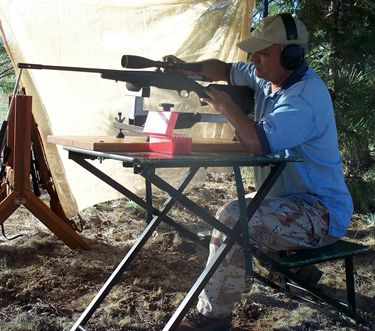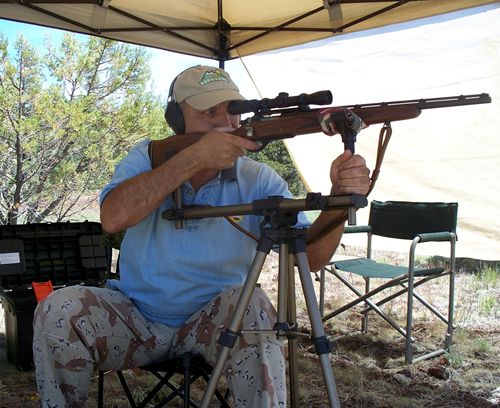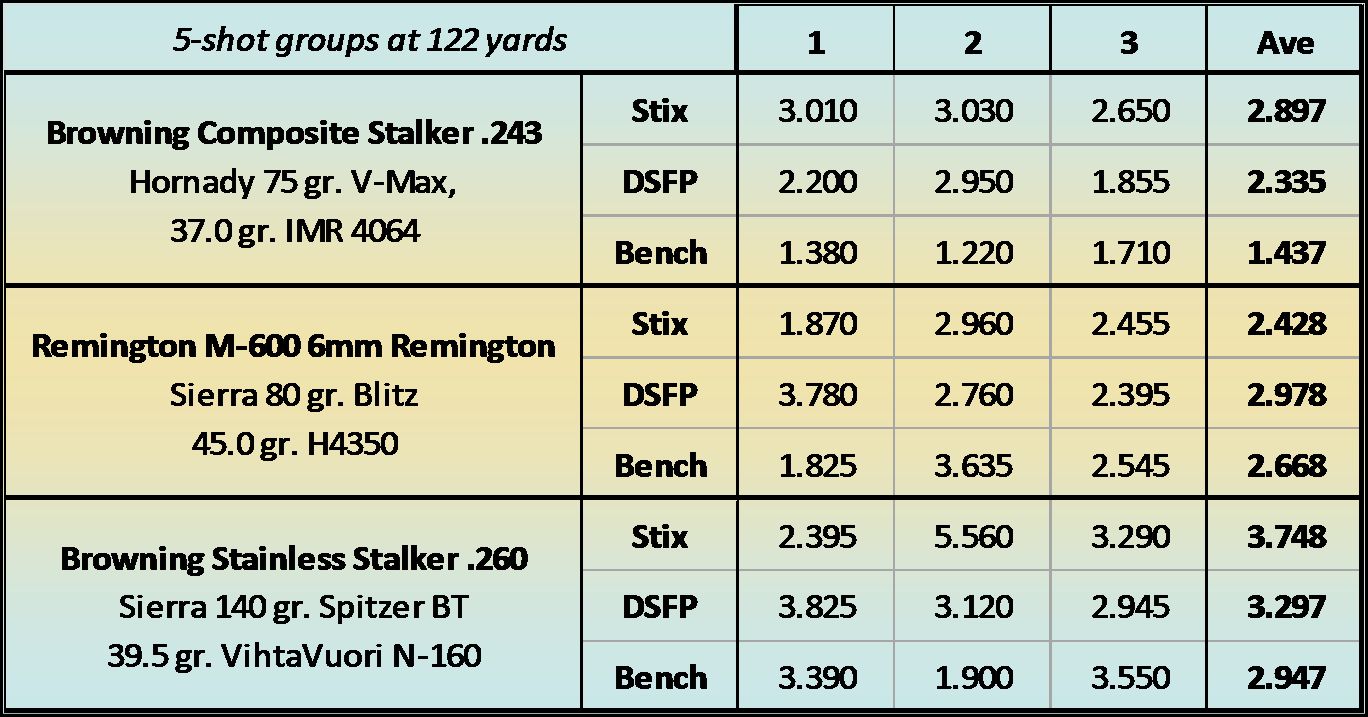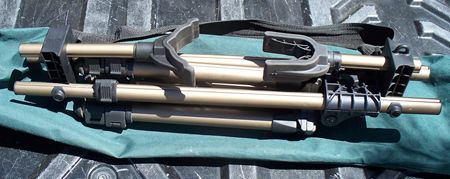
| Articles | Documents | Equipment | Events | Links | Membership | Miscellaneous | Scrapbook | Targets | What's New |
| Gear Review: Caldwell DeadShot FieldPod | June 2013 | |||||||||
| Dan Martinez | ||||||||||
|
In past stories, I’ve written about using shooting sticks in the field,
and I’ve also written about rifle blind hunting –using both natural
blinds and manufactured blinds. When blind hunting in the past, I have
used my shooting sticks for rifle support. But now I’ve discovered a
neat new gizmo called the Caldwell DeadShot FieldPod which is a
heck of an improvement for rifle support in a blind or other ambush setup.
Yes, that name is quite a mouthful, so I normally just refer to it as
the “field pod” or the “DSFP”. It sort of looks like a camera tripod,
but it is not. The lower half is a tripod with three-section telescoping
legs. The upper half consists of a twin-tube support beam with two forks
to support your rifle at the front and rear of the stock.
The support beam does not separate from the tripod. There would be no
way to mount a camera or spotting scope on the tripod if you did remove
the beam. To transport the device in the field, it folds and collapses
into a compact bundle 23½” long by about 6” tall and wide. It comes with
a strap for use as a carrying sling, but I don’t use it. Instead, I put
it into a cordura canvas bag that used to be the storage sack for a compact
folding chair. This I strap to my Eberlestock X2 hunting pack. My fish
scale says that the field pod in the sack weighs 5.2 pounds.
To deploy the field pod when you reach a setup spot, you begin by loosening
up every adjustment mechanism on the device – and there are a lot of them!
If I think about it, I come up with 13 adjustment points.
Six of them are the leg slider locks. The height of the field pod adjusts
from 20” to 42”. That’s enough adjustment range to allow use from a
ground-seated position to a chair-seated position. It does not extend high
enough to use from a standing position.
Finally, there is one more knob that locks down the fore and aft position of
the beam with respect to the tilt and swivel hub at the top of the tripod.
This is an important setting that sets the balance point of the unit.
Basically, you want to adjust this position to place the rifle’s balance
point directly over the tilt and swivel hub.
When you play with the DSFP for the first time, all the adjustments can be
quite daunting. But with some experience, you become familiar with what each
does and why it is necessary. But all the twisting, sliding, and locking does
take a minute or two of effort to get set up. But the beauty of it is that
once you do get it set up, your rifle is ready, in-position, for the rest of
the day, and your hands are free.
I picked up the DeadShot FieldPod just before last year’s deer hunt. I found
myself a great little sniper spot about 150 yards up a slope from a waterhole.
I hunted this spot for several days by hiking in with both the field pod and
a hunting chair strapped to my pack.
I was back under a tree behind some bushes. It was a perfectly comfortable
spot to spend all day watching over the waterhole for several days. I did
have a bobcat and a young buck walk into my killing zone while I waited in
ambush. I was able to put perfectly steady crosshairs on each animal with
the field pod. It really is the next best thing to having a bench rest out
in the field with you.
I let both critters walk. The buck was a forkhorn. He walked up to the water
very hesitantly. He would take a step or two and just freeze, trying to sense
any danger. At these frozen moments, I had his kill zone perfectly centered
in the crosshairs. All I had to do was “push the button” and he would have
been mine. Nope, he just wasn’t what I was looking for, so he drank without
any interference from me.
Something that I’ve been wanting to do since getting the DSFP was to test the
steadiness compared to my favorite old shooting sticks, and also against a
bench rest. I finally got around to doing that this Memorial Day weekend.
My test plan was as follows: Gather three favorite rifles, shoot three groups
of five from each, from each of three positions – from sticks while seated on
the ground, from the DSFP while seated in a blind chair, and from benchrest.
That makes 15 shots from each position per rifle, for a total of 45 shots fired
from each rifle.
I headed up to cooler country for this test. I found myself a nice spot at an elevation of 6500 feet, set up some shade, and commenced to firing for the rest of the day. One major problem though – cedar gnats! They are also called no-see-ums, or biting midges. The term cedar gnat is common here in Arizona because they are most often found in the cedar (juniper) elevations of 3800 to 6800 feet. They are basically very tiny mosquitos. As tiny as they are, they are capable of biting human skin. Throughout the day I did my best to fend them off, but it can be tough to hold good groups when they are flying into your eyes and ears and taking blood samples when they can! So please judge me not too harshly on my absolute group numbers, but instead let’s focus on the relative differences between group sizes for the three rest types. Also keep in mind that this is the full data as fired. I did not remove any fliers or called bad shots. The overall results came out pretty much as you would expect. The tightest groups came from benchrest, the loosest groups from the sticks, with the DeadShot FieldPod giving groups somewhere in between. The Remington Model 600 though did produce the anomalous result that the sticks shot tighter than the DSFP or the bench! I’m not sure that I can explain that except to chalk it up to luck and unluck. Overall, my best groups off the sticks came from the M600, even though the .243 had the best raw accuracy of the three guns. The M600 has a scope that tops out at 7x. The .243 was cranked up to max magnification of 16x, while the .260 was set to max at 9x. So whether it was the lower magnification, or maybe the square fore-end on the M600, the crosshairs just seemed to settle better with this rifle on the sticks.
Group sizes with the .260 were generally disappointing. I normally don’t shoot bullets as heavy as 140 gr. in the .260, and this was my first trial with VihtaVuori N-160. But I have a bunch of 140 grain 6.5mm bullets that I “inherited” and have been looking for some excuse to shoot them up. This seemed like a good opportunity. When holding a rifle on the field pod, it really does feel benchrest steady. You see very little wobble of the crosshairs. In the hopes of increasing accuracy a little, I place the extra padding of a folded up bandana between the rifle fore-end and the front fork rubber. For the .243 the difference in average group size from bench to field pod was about .9 inches. For the M600 it was only .31 inches, and for the .260 it was only .35 inches. That’s not too bad. Unless you have someone else who can carry it for you, the DSFP at around five pounds is not something you are going to want to haul around with you all day as you are hiking the hills in search of game. Shooting sticks that fold up and double as a walking stick is still the best solution for humping the hills in my opinion.
© Honeywell Sportsman Club. All rights reserved. | ||||||||||
| If you enjoyed this story, or found it useful, please consider clicking here to join the NRA at a discount of $15 off the normal membership cost. You will be supporting both this website and adding your voice in support of the Second Amendment. Thank you very much. |
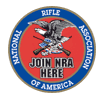
|

|
|
